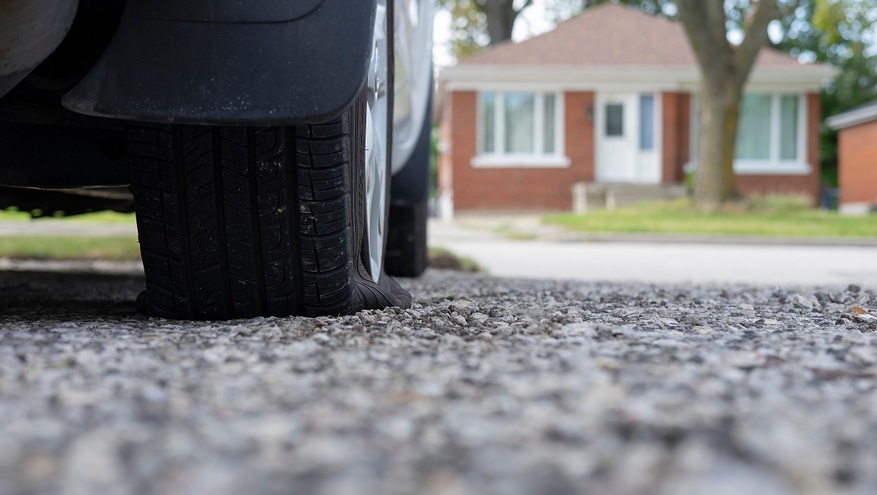Today, about 40% of new cars come without a spare tire, leaving many drivers unprepared for unexpected situations. Recently, I learned firsthand just how important a spare can be.
I was heading north back to Moab from a drive exploring beautiful southeastern Utah. I hit a pothole on the highway that ripped a softball-size hole in my front passenger tire. It was pitch black, I had no cell service, and I was more than 20 miles from the nearest town. Fortunately, I was able to limp back on the reinforced sidewall of my run-flat tire. But once I was back, my problems weren’t over. No one had tires in my size. I had to rent a car, drive to Grand Junction, Colorado, buy a tire and take it back to Moab to be mounted on my car.
The entire experience was a huge inconvenience. If my car had included a spare tire, it would have saved me time and money.
Get a HELOC Before You Need One
Just as a spare tire can be a lifesaver during an unexpected flat, a home equity line of credit (HELOC) can be a useful tool, providing critical financial support when handling major expenses or unexpected opportunities — if you already have one set up.
Typically offering no closing costs and no payments until you use it, a HELOC provides the flexibility to support your financial strategy. When used thoughtfully, it can help you navigate life’s twists and turns while staying on track with your long-term goals—offering peace of mind that your finances have their own spare tire (even if your car doesn’t!).
What is a HELOC?
A HELOC is a type of second mortgage and revolving line of credit secured by your home's equity. Unlike a traditional home equity loan, it allows you to borrow as needed during a draw period and pay off the balance to replenish your available credit for future use.
Typically, you may be able to borrow up to about 80% of your home’s value, depending on your credit score and other factors. From that amount, the remaining balance on your first mortgage is subtracted to determine how much equity you can access. For example, if your home is appraised at $300,000, 80% of its value would be $240,000. If you still owe $200,000 on your first mortgage, that amount is subtracted from $240,000, leaving you with a potential borrowing limit of $40,000 through a HELOC.
HELOC rates are variable and tied to the prime rate, which is influenced by the federal funds rate set by the Federal Open Market Committee. As that rate adjusts, the cost of borrowing a HELOC can fluctuate. With rates widely expected to continue a downward trend over the next couple of years, HELOCs may become even more affordable. Plus, during the initial 10-year draw period, you only pay interest on what you draw from your HELOC, making it a cost-effective solution compared to unsecured loans, credit cards, personal loans and other types of financing.
However, it’s essential to borrow responsibly and with a clear repayment plan, as your home serves as collateral for the loan.
How HELOCs Can Save the Day
A HELOC is a versatile financial tool, offering flexibility to help with a wide range of needs. However, it should always align with your financial goals. Whether you’re covering practical expenses or funding once-in-a-lifetime events, it’s essential to have a thoughtful plan to repay anything you borrow to avoid unnecessary financial strain.
Here are 10 ways you can use a HELOC:
Build Equity
1. Home Improvements: Finish a basement, add a deck or remodel a bathroom to boost your home’s value.
2. Real Estate Purchases: Use funds for a down payment on a vacation home, an investment property, or to purchase land. You can also use a HELOC as a bridge loan — a short-term solution that helps cover costs while transitioning between selling your current home and buying or building a new one.
Replace Other Forms of Debt
3. Debt Consolidation: Pay off high-interest debts to simplify your budget and increase cash flow.
4. Education: Avoid high-interest student loans by paying for tuition, books and other education-related expenses with HELOC funds.
5. Business Startups: Launch a new business or side hustle by using a HELOC to pay for equipment, marketing or legal expenses.
Create a Safety Net
6. Emergency Funds: Quickly cover unexpected costs like car repairs, temporary income gaps or other urgent financial needs.
7. Major Home Repairs: Fix a damaged roof or a dying HVAC system to keep your home safe and comfortable.
8. Medical Expenses: Pay off large medical expenses over time while avoiding high-interest credit card debt.
Fund Once-in-a-Lifetime Events
A note of caution: While a HELOC can help make dreams a reality, use it wisely for discretionary, or non-essential, types of expenses. These funds are tied to your home’s equity, so ensure you have a solid repayment plan before using them for travel or special occasions.
9. Vacations: Make memories on a family trip without causing credit card balances to spike.
10. Weddings: Cover expenses to help make the special day as perfect as possible for the newlyweds.
Tips for Getting the Most Out of a HELOC
If you’re considering a HELOC, here are some features and tips to keep in mind to ensure it’s the right fit for your needs:
Understand the Costs
- Look for HELOCs with no application fees, appraisal fees or other closing costs. These savings can make a big difference upfront if you qualify.
- Choose a HELOC with no annual fees to keep ongoing costs low and manageable.
- Be mindful of variable interest rates. While HELOCs can have lower rates than other types of loans, those rates can fluctuate over time.
- Research lenders who offer low introductory rates.
Take Advantage of Flexibility
- Make interest-only payments during the 10-year draw period to keep costs lower. You’ll have to make principal and interest payments during the 10-year repayment period.
- Re-borrow funds if needed as you pay down your balance during the draw period.
Know What’s Available
- Get a HELOC on a primary residence, second home or investment property.
- Understand regional restrictions. Many banks offer HELOCs only within specific areas. Bank of Utah provides HELOCs for properties located in Utah, Idaho and Nevada, for example.
- Check borrowing limits. Bank of Utah’s, for example, is $750,000, depending on the property and your available equity.
Make the Process Easy and Empowering
- Consider a lender that offers multiple ways to apply, such as in person, over the phone or online from your phone, tablet or computer.
- Work with seasoned, local professionals, like those of us at Bank of Utah, to help you make informed decisions and tailor the HELOC to your specific financial situation.
Final Thoughts
HELOCs have long been a reliable way for homeowners to access funds, and their appeal has only grown in recent years. As home values have risen, many homeowners now have more equity to draw from, making HELOCs a practical option for turning that equity into usable cash. One of their biggest advantages is that they allow you to access funds without altering the terms or interest rate of your existing mortgage — especially beneficial if you’ve locked in a low rate.
Whether you’re planning to use a HELOC for home improvements, debt consolidation or just to have as a backup plan in case your budget gets an unexpected financial flat-tire, the flexibility and convenience of a home equity line of credit make it a smart financial tool. Reach out today to your local Bank of Utah mortgage loan officer with any questions or to apply for a HELOC — we’re always happy to help.
 Matt Gollihur, a mortgage and construction loan officer for Bank of Utah, supports clients and real estate industry partners throughout Utah and beyond from the Sandy branch. He began his mortgage career in 1996 and joined Bank of Utah’s mortgage team in 2024. Outside work, Matt enjoys spending time with his wife and three children, traveling and exploring the great outdoors.
Matt Gollihur, a mortgage and construction loan officer for Bank of Utah, supports clients and real estate industry partners throughout Utah and beyond from the Sandy branch. He began his mortgage career in 1996 and joined Bank of Utah’s mortgage team in 2024. Outside work, Matt enjoys spending time with his wife and three children, traveling and exploring the great outdoors.




